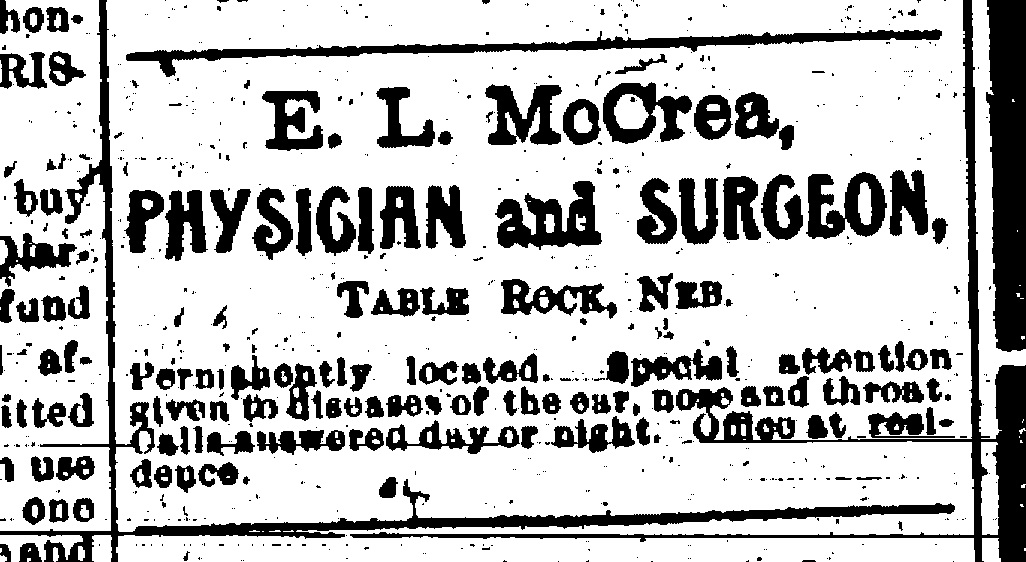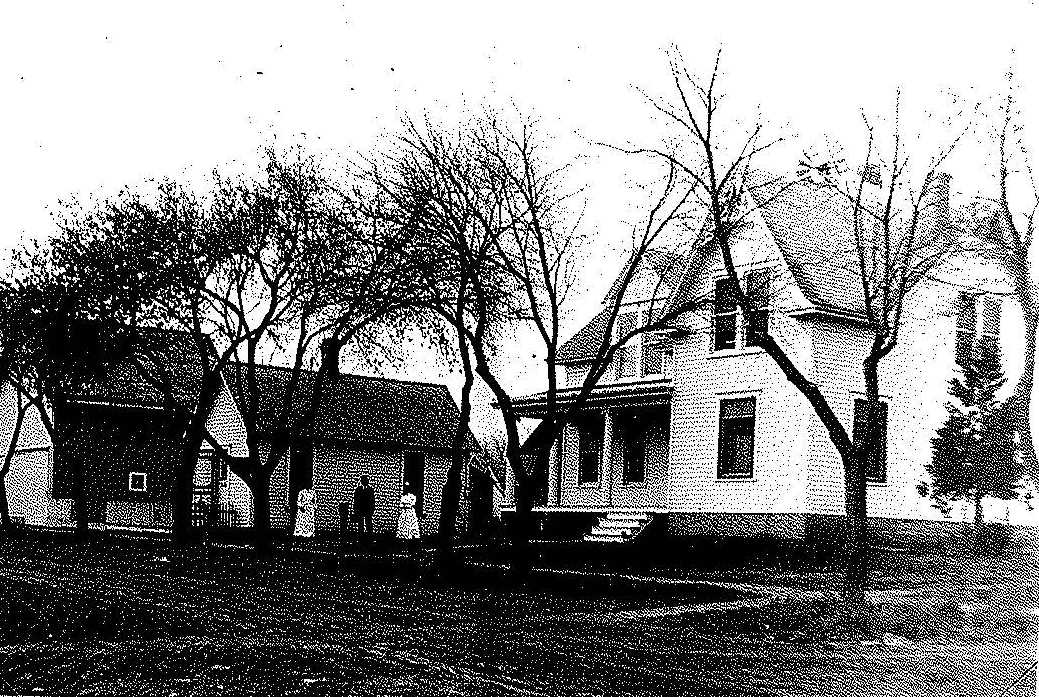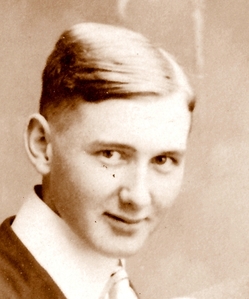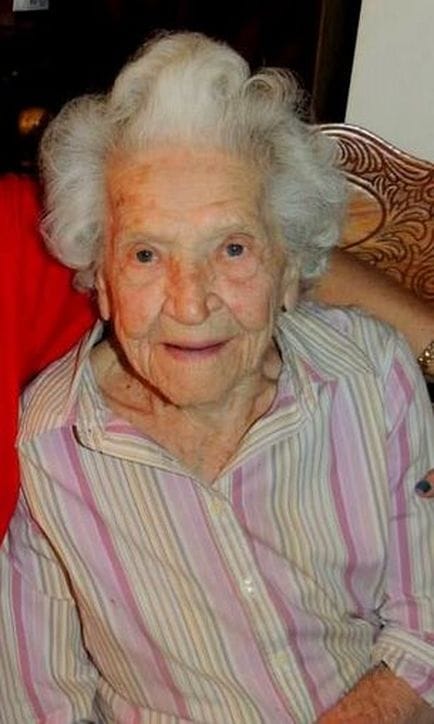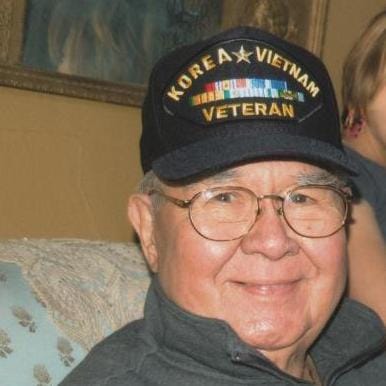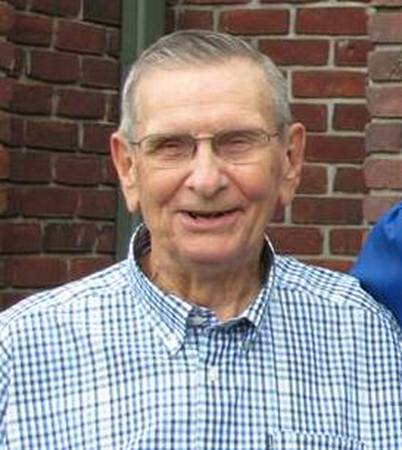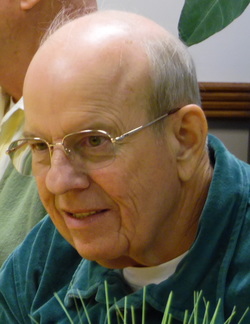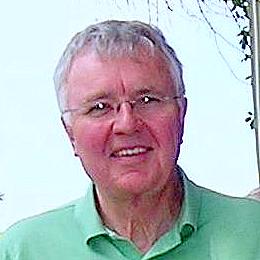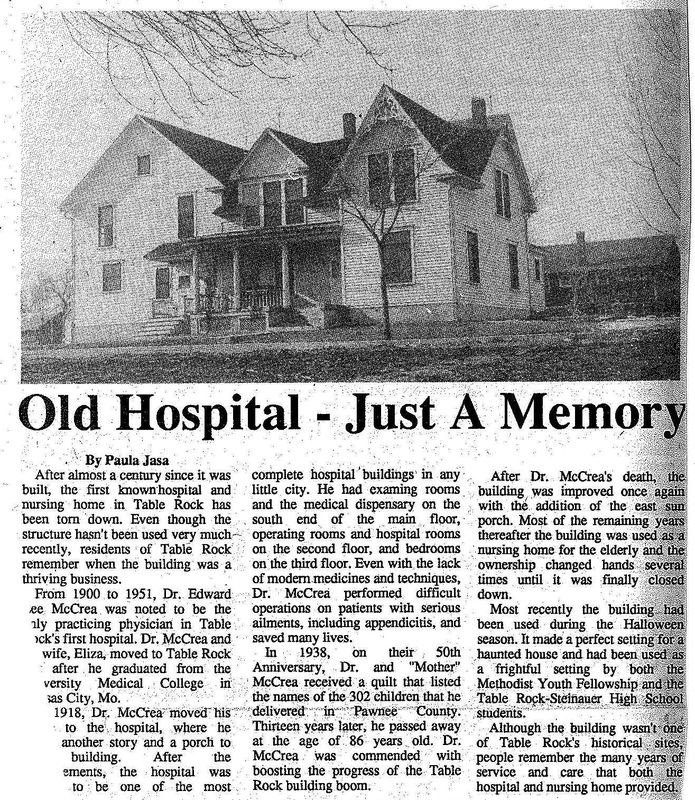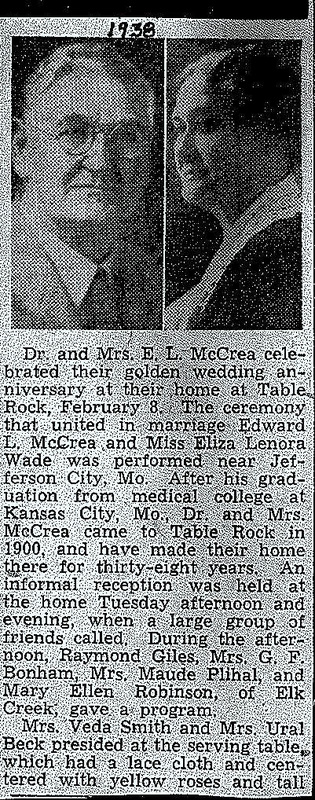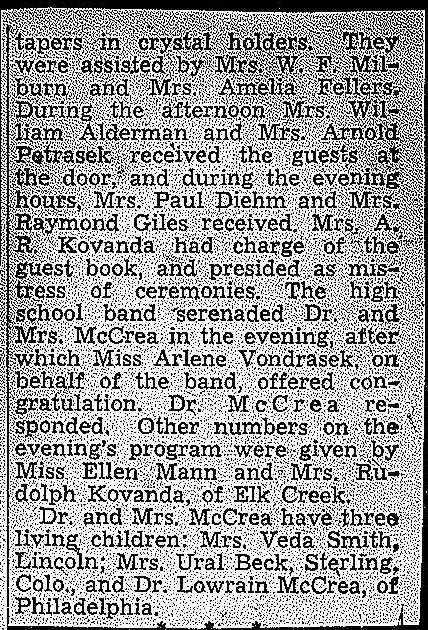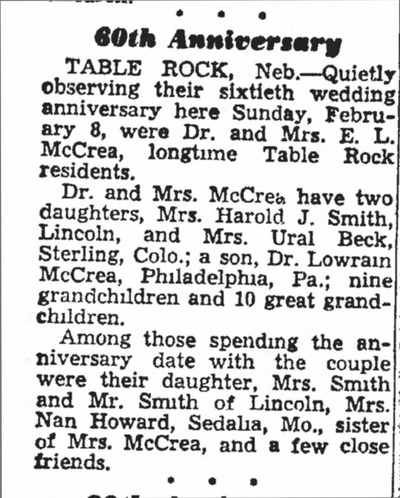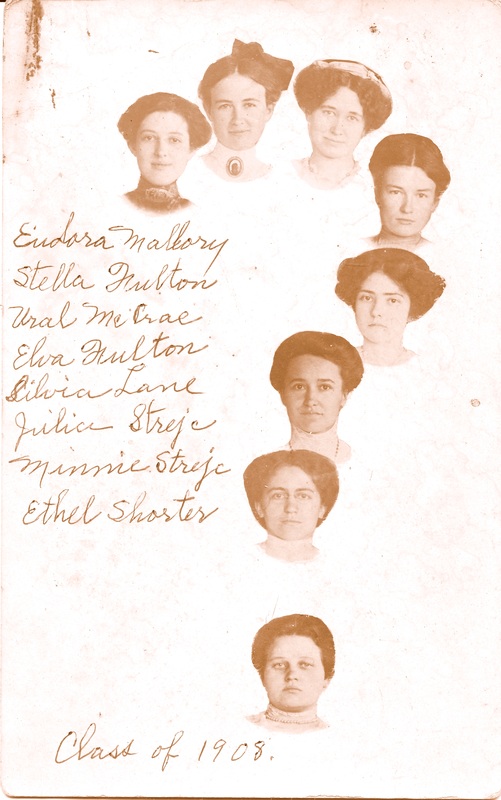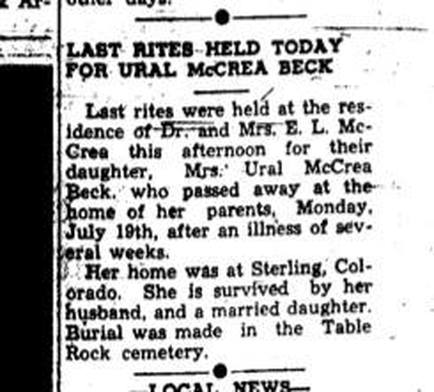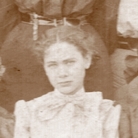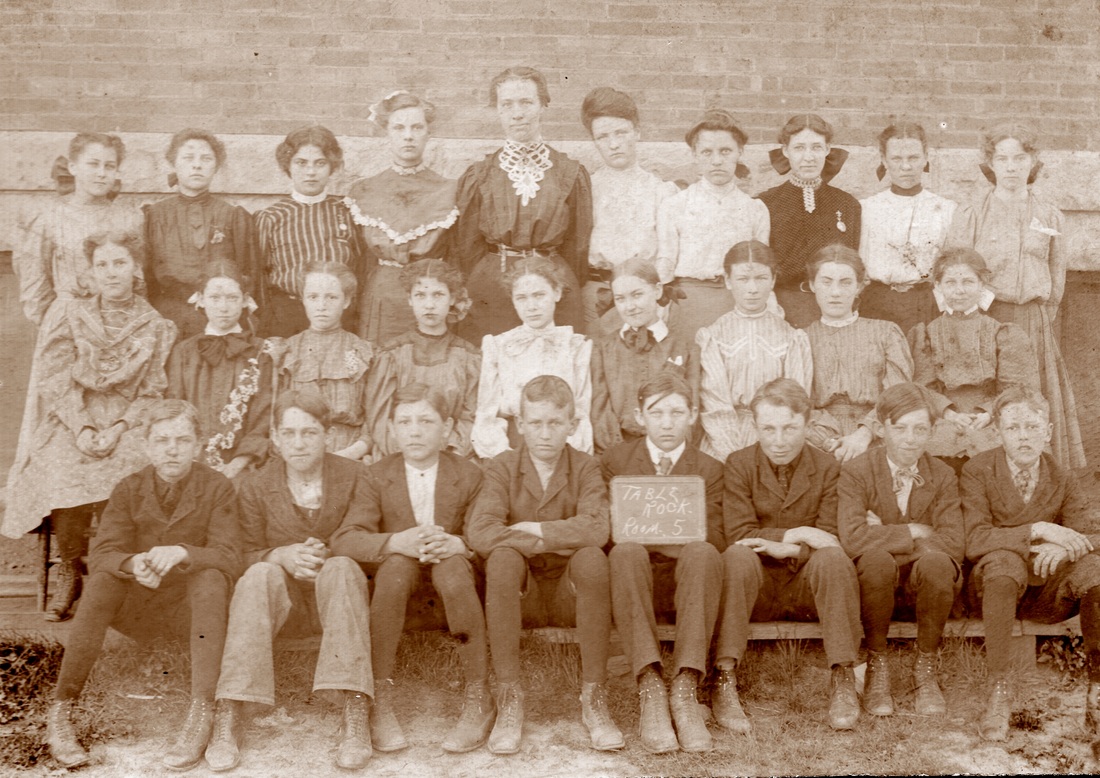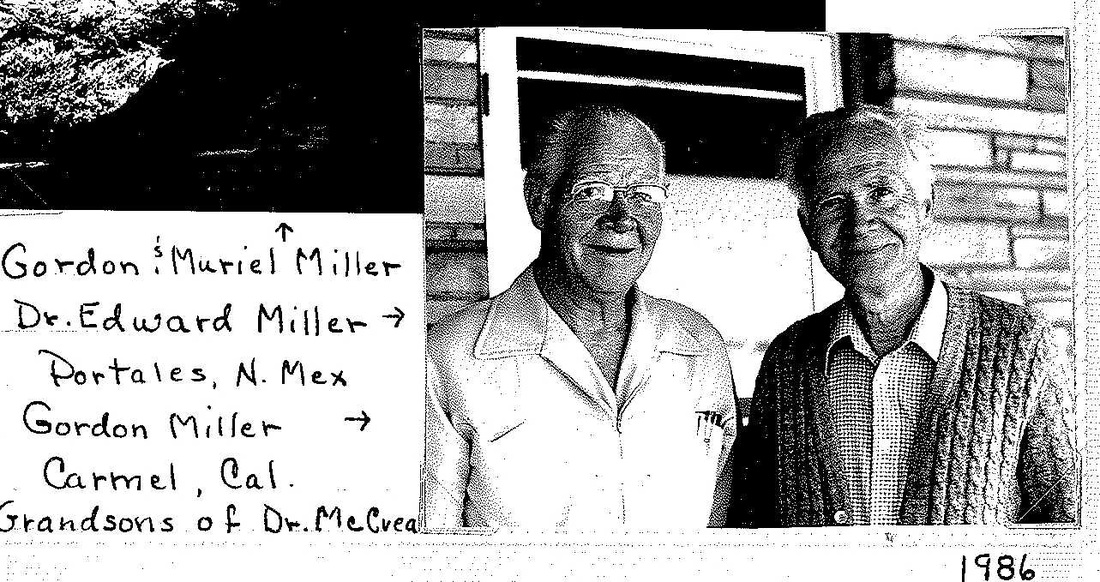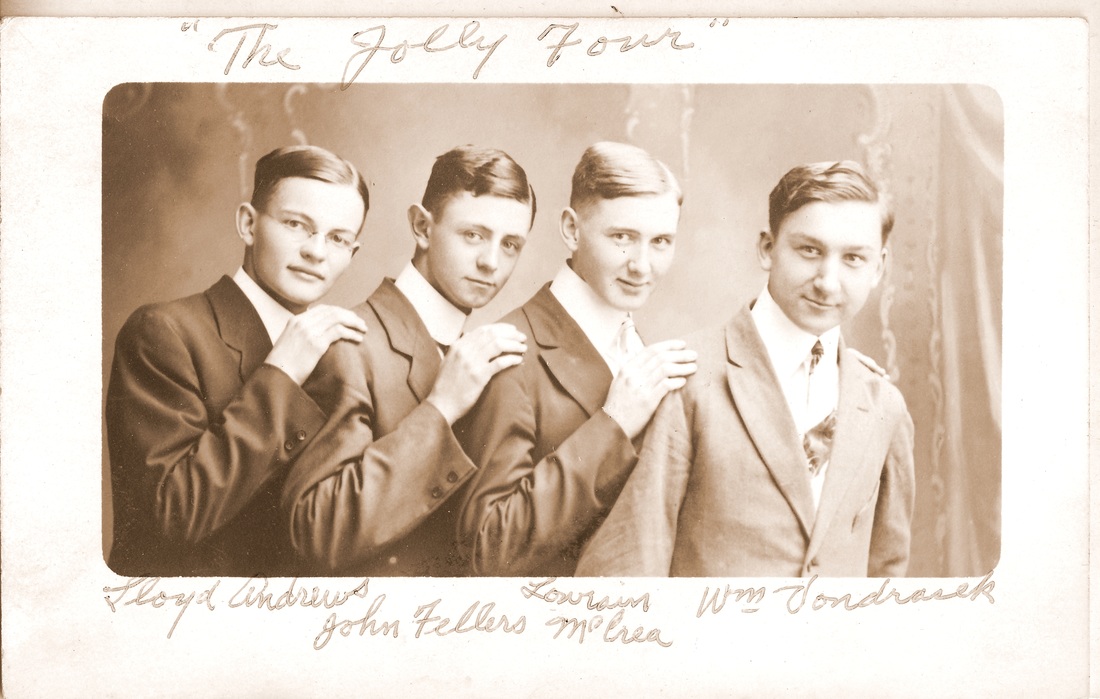dr. ed mccrea - worth remembering
dr. mccrea -- a successful veterinarian in missouri who then went to medical school
We know something about Dr. McCrea because he left his memoirs. In them, Dr. McCrea said he was the son of a Missouri cattleman who had traveled there with Daniel Boone. Dr. McCrea was raised in the saddle, and he was “always happy with a herd of cattle” to drive.
At 26, he became a veterinarian. He was a young married man beginning a family. He built up a good practice in Missouri that increased “by leaps and bounds” after his cool testimony in a complicated legal case between ranchers arguing about whose cattle had brought Texas fever. He traveled by train to distant places to operate on “fine animals” and consult.
At 26, he became a veterinarian. He was a young married man beginning a family. He built up a good practice in Missouri that increased “by leaps and bounds” after his cool testimony in a complicated legal case between ranchers arguing about whose cattle had brought Texas fever. He traveled by train to distant places to operate on “fine animals” and consult.
Then his mother suffered a burst appendix, something the doctors did not identify. She died, after prolonged -- and he believed unnecessary -- agony. It lasted two months, and there was no surgical intervention.
He left his successful veterinary practice to go to medical school.
He left his successful veterinary practice to go to medical school.
|
After graduating from medical school in Kansas City, he and his wife Eliza headed to Mexico, where it seemed that there would be a demand for doctors. However, as he approached Mexico he heard that it was in chaos as a result of the Spanish-American War. He decided it was “no place for a gringo.” He went searching elsewhere and ended up in Table Rock. That was in 1900. He was 35 and had four young children.
|
dr. mccrea's early years in table rock -- ambitious, on-the-go
Dr. McCrea was a man of energy and ambition. There were two other doctors in Table Rock then. But not for long. In those days, the doctor went to the patient. There were no phones in his earliest days in town; a messenger was sent for the doctor. And Dr. McCrea was ready when the messenger arrived. He cheerily recalled that he drove the other doctors out of business by his availability:
I soon got the [medical] practice of the county, driving day and night. I rode in a buggy, having three and four teams of my own and two livery barns in town to use their teams. I had fine horses and I drove like the wind. There was plenty of fruit, and I lived on apples, never stopping to eat. I would change teams and go again. (Two other physicians, Dr. Cherry and Dr. Wilson, eventually did join him in Table Rock.
|
the travails of house calls
|
Dr. McCrae calmly faced the weather, nothing new to him since he had grown up living in the open. As a country doctor, he accepted great hardships.
He endured blizzards in which he thought he would freeze to death despite being dressed in fur. When snow was too deep to stay to the road, he cut fences to go across fields. When the snow was too deep for a buggy, he went on horseback. One year the snow was so deep that he bought a sled and drove for miles on frozen drifts. Floods were fearful. He recalled going to see a patient on a wet night; the river had been up but had subsided enough to get there. He treated a little girl who had gone into convulsions. There were phones by then, and there came a call that “another rise was coming” on the river. He hurried toward home. He entered the river bottom, and then |
When I got about halfway across , there was a wall of water about two feet coming from about one hundred yards north of the road. I could only go so fast, but I got within two hundred yards of the bridge when the wall of water hit us. I pulled the team upstream. The buggy floated around as though we were going back. The water was over the fence posts and it was hard to tell where to go. I kept my eye on the bridge and made for the center so I would not get into the fence. I got good and wet but I made the grade.
a place for patients to come to him
Dr. McCrea put his earnings back into his practice. The first year, he built an office, the next a barn, the next a residence. Later he built a hospital on the south side of the street from the Christian Church, and then, even later, added to it substantially.
dr. mccrea goes from horses to horseless carriages
In his autobiography, he reports that he was the first man in Table Rock to get a “horseless buggy.” He bought it in St. Louis and had it shipped by express. “When the boys had it to unload from the express cart, it was a task. Everybody and dad was called to lift the machine and get it on the platform.” The next day they loaded it on a dray cart to take to Upper Town and Table Rock turned out to see it. It had high wheels driven by chain, and a six-horse marine engine with “one lung” (cylinder). He got a mechanic from Humboldt to take the first drive. He was unhappy with it in the end. It ran on dry ground but wouldn’t pull its own weight up a hill. He sent for another.
His night runs remained difficult even with cars. He wrote:
The cars then had carbide lamps and you had to make your own light. They gave a great deal of trouble. One night I had to make a drive and I took my son [Lowraine, who later became a doctor himself] with me. We had no lights and it was quite dark. We could not see the road so I tied the lantern over the radiator but the car going over the rough road following the wagon tracks; as it had high wheels and solid tires, it did not ride like pneumatic tires, [so jolts] would put the light out. So to get along, my son sat on top of the hood and held the lantern. We were tired. It was cold, but the engine warmed the hood so he did not suffer very much. Dr. McCrea hated Fords. “A man has H____ enough on earth without driving a Ford,” he wrote. He had bought a Ford, even though a mechanic told him not to, because it could not go anywhere when the mud was deep. The mechanic was right. Then a wheel came off when he was going 60 miles an hour, the wheel “jumping like a jack rabbit” as it hit bumps on its merry way. He got rid of that Ford and never bought another. |
|
He went through a lot of cars after that. His lifestyle was hard on them. In the early days, there was no mechanic in Table Rock so he did his own work. He sometimes worked on a car all night to be ready for the next day. His cars had hard use and he had troubles. One time the steering gear broke as he crossed the bridge “in the east part of town” and the springs, which were like buggy springs, stuck in the ground so that the car stood almost straight up. Only his slow speed saved him from a “flip flop.” Over the years, he had seven steering gears break and five wheels fall off while driving.
dr. mccrea and his patients
Dr. McCrea did a lot of treating over his years, and in his memoirs describes various cases. It is also said that he did considerable surgery at his hospital. He seems to have been dedicated to his patients, but matter-of-fact and business-like with them. He gave a few lectures in his time. There was a man with a heart condition who decided patent medicine was better than a doctor, to bad effect. Dr. McCrea said, “I thought it was a good time to give him a lecture.” Then there was a three-year-old girl who he had been sent for because she was dying; when he arrived, everyone was wringing their hands and pulling their hair. He found the girl “so nervous she could not sit still, and delirious.” It turned out that they had let her have three cups of coffee for breakfast, three for dinner, and four for supper. Another lecture followed.
he loved the outdoors and traveling
|
Dr. McCrea was not all about medicine.
He loved to hunt. I was good with a rifle. I could shoot anything running or flying, as well as standing still...I was trained by an old hunter who learned many tricks about wild animals. I could smell a squirrel when he came out of his nest a long way away. In his autobiography, he told many stories of days in the field. In his eighties, he said,
The woods haunt me yet. I have a longing to go. He also loved to travel. He believed that people should see the United States first before traveling abroad, and touted the marvels of the country. He traveled from coast to coast, from Canada to Mexico. He traveled to see nature.
|
This country doctor said, “I have looked at the skyscrapers in New York City, but they are not natural” and he described other places he had been to be more awe-inspiring, all places in nature.
Dr. McCrea elected Bryce Canyon as the most beautiful place in the country, followed by the Grand Canyon. But he also described with enthusiasm Bridal Falls in Yosemite National Park, the Kibab woods, the Rockies, Vermont, and Niagara Falls.
This country doctor “gazed upon big trees and drove through a big tree,” he stood at the summit of Mount Rainier, walked in the forests by Puget sound, fished in the Yellowstone River.
This country doctor remembered a day on Lake Michigan when the “the weather was fine and the water was very smooth and not a ripple.”
Clearly, he got around.
Dr. McCrea elected Bryce Canyon as the most beautiful place in the country, followed by the Grand Canyon. But he also described with enthusiasm Bridal Falls in Yosemite National Park, the Kibab woods, the Rockies, Vermont, and Niagara Falls.
This country doctor “gazed upon big trees and drove through a big tree,” he stood at the summit of Mount Rainier, walked in the forests by Puget sound, fished in the Yellowstone River.
This country doctor remembered a day on Lake Michigan when the “the weather was fine and the water was very smooth and not a ripple.”
Clearly, he got around.
he loved woodworking
He loved working with wood, especially walnut. He made coffins for himself and Mother McCrea many years before their deaths. He reportedly took people to his workshop, to see them on display, and they were beautifully done.
his thoughts about the end of his life
Sitting at his desk – probably the very one here in the Pioneer Museum -- Dr. McCrea penned prose that was as elegant and probing as poetry. He concluded his memoirs with these observations about he and his wife Eliza, known affectionately by all as Mother McCrea
“As I sit in my study and see the autumn leaves falling, it brings thoughts of happy days that have passed, when life was happy and gay and we sang the songs of long ago. Those songs we cherish so today we sang to our loved ones, but two have passed away and now we are old and alone. The days go swiftly by and we wonder who next will be going, Mother or I. I hope the life I have lived has been a useful one....”
Dr. McCrea died in 1951 at the age of 86. Eliza followed a few years later. They were each buried in coffins he had built.
dr. ed mccrea - a man worth remembering
I love to watch life. I am part of it.
DR. MCCREA -- A MAN REMEMBERED
FOR A more COMPLETE LIST OF BABIES delivered by dr. mccrea, IGNORE THE REMAINDER OF OF THIS PAGE AND GO TO THE NEW PAGE:
DR. MCCREA IS SAID TO have DELIVERED 302 BABIES. Here are a few who, happily, are still with us.
a baby delivered by dr. mccrea in 1915 - beulah kreifel myers
On February 16, 2016, Beulah turned 99. Niece Susie Kreifel Huber reported Beulah's birthday, and said:
Aunt Beulah told me Dr. McCrea traveled by horse & buggy from Table Rock to deliver her in Elk Creek, Nebr. Dr. McCrea also delivered, my aunt Bernice Hillers, my aunt Viola Fredericks, and my father, George (Babe) Kreifel, but all 3 of those are deceased now. Aunt Beulah at 99 is living in her own home, making homemade bread, mowing her lawn, etc. at her age. As Susie points out, Beulah may be the oldest living baby delivered by Dr. McCrea.
Dr. McCrea delivered Beulah's sister Bernice in 1919. In 1924, Dr. McCrea delivered their brother Babe Kreifel, seen below with his friend of over 80 years, Lawrence Petrashek. It is still to be confirmed but since Lawrence was born just east of Table Rock, Dr. McCrea probably delivered him as well; he was born in 1923. Bernice passed away in 2000, Lawrence in 2009, and Babe in 2010. |
a baby delivered by dr. mccrea in 1926 - floyd vrtiska
At age 88, Floyd remembers the doctor who brought him into the world and treated his aches and pains through his teenage years.
a baby delivered by dr. mccrea in 1926 - lloyd vrtiska

Yep, there were two of them! Floyd's twin brother Lloyd is on the list. too!
a baby delivered by dr. mccrea in 1926 - darlene wilcox turnbull
i was born in Table Rock in 1926, in a house that used to be a church. Of course Dr. McCrea delivered me. Who else would there have been?! |
a baby delivered by dr. mccrea in 1928 - ardis gottula hunzeker
Ardis graduated from Table Rock in 1945, along with other notables including Willard Binder, Joe Sochor, and Art Alderman. j In November 2016, she visited the Argus Museum in the company of two of her children, Russ Hunzeker and Judy Siefken. We stopped at the desk of Dr. Ed McCrea, and I asked if she was born in Table Rock. "Oh yes," she said, "And Dr. McCrea delivered me!" I forgot to ask her what the year was!
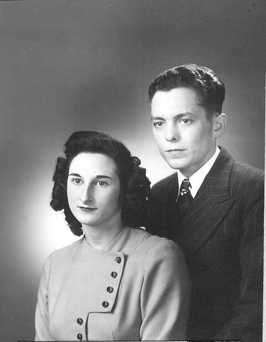
Son Russell gave me a picture of a young Ardis and her husband Arthur, who has passed away.
a baby delivered by dr. mccrea in 1928 - evelyn kalina michaelis
margaret muscheites hunt, 1929
|
Margaret's daughter Terry Korell remembers:
He delivered my mom, Margaret Muscheites, in 1929, at the hospital. Mom used to point out the window where her mom's room was. |
a baby delivered by dr. mccrea in 1929 - david d. lang
a baby delivered by dr. mccrea in 1931 - edward tomek
Dr. McCrea delivered me in 1931. |
a baby delivered by dr. mccrea -- milan tomek
the good doctor remembered
donna brown-mcmann
When I was little, my sisters would chase me and scare me. Well, one day when theyt were chasing me I fell on a broken fruit jar. Dad held it together and took me to Doc Mcrea, who sewed my arm up. Dad said my arm was almost cut in two. Dr. McCrea did a great job. I have full use of my arm and am just a little numb where the scar is. |
larry layden
Larry Layden remembers Dr. McCrea:
He made house calls when I was a child. Us kids kind of looked forward to getting sick and having the Dr come to us because he always has a supply of Hershey candy bars in his doctor's bag and he would give us one when he left. |
glenda alderman blecha
ken ahntholz
dr. mccrea's hospital
Dr. McCrea’s hospital closed but the building lingered for a long while. It housed a nursing home for many years, and toward the end was used as a haunted house by the Methodist youth group and also by high school kids. Nothing remains of it.
What remains of Dr. McCrea in Table Rock is his and Mother McCrea’s tombstones in the Table Rock Cemetery. And some of the 302 babies that he delivered up to 114 years ago, when he went into practice in Table Rock in 1900 -- and their children, and grandchildren, and great grandchildren and great-great grand grandchildren.
What remains of Dr. McCrea in Table Rock is his and Mother McCrea’s tombstones in the Table Rock Cemetery. And some of the 302 babies that he delivered up to 114 years ago, when he went into practice in Table Rock in 1900 -- and their children, and grandchildren, and great grandchildren and great-great grand grandchildren.
read dr. mccrea's autobiography for yourself. here is the full text of "a book about my life," by e. l. mccrea.
| 8b-8_a_book_about_my_life_-_dr._e._l._mccrea.pdf | |
| File Size: | 15334 kb |
| File Type: | |
in the museum - dr. mccrea's desk
more
50th wedding anniversary, 1938
60th wedding anniversary - 1948
an addendum: the four mccrea children
Dr. McCrea was born at the close of the Civil War, in 1865. In 1888, he married Eliza Wade; he was 23. They had four children: Veda, Ural (1890 - 1948), Zelma (1892 - 1924), and Lowrain (1896 - 1980).
Eliza - Mother McCrea -- was the same age as he. She lived a few years longer. Dr. McCrea died in 1951, she in 1954.
Eliza - Mother McCrea -- was the same age as he. She lived a few years longer. Dr. McCrea died in 1951, she in 1954.
veda
Sadly, we know little about Veda at this time. She married Harold J. Smith and lived in Lincoln at one time. She had at least one child, Arlene.
ural (1890 - 1948)
Ural was born in 1890. She graduated from high school in 1908. She married and had a daughter. She died in 1948 at the age of 58.
zelma (1892 - 1924)
We know some data. She married Gordon David Miller (1885-1961); he was the son of David K. Miller, a farmer and a cashier at the State Bank of Table Rock from when it was founded in 1885. Zelma died young; she was only 32 when she died in 1924. She is buried in Pawnee City.
We do know something personal about her: she was a violinist -- so says this August 1907 newspaper article from the Table Rock Argus.
|
Zelma's son Edward Lee Miller became a doctor like his grandfather Edward Lee McCrea; Dr. Miller practiced in New Mexico. Here he is in 1986, at which time he lived in Portales, New Mexico. On the right his his brother Gordon of Carmel, California.
Dr. Miller died in Portales in 1993 at the age of 76. |


